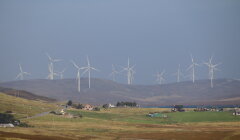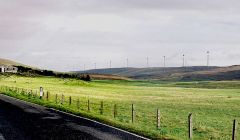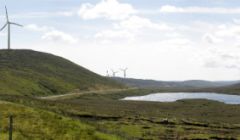Letters / Open letter to councillors from Sustainable Shetland
Dear councillors,
Among the papers appended to the SIC Planning Officer’s report on the Viking wind farm variation application, is a “Checking Report” prepared for the Energy Consents Unit by Dr. Andy Mills of AM Geomorphology.
I should like to bring this, and the attached response to it, which has been published on the relevant page of the ECU website, to the attention of SIC councillors and the wider public.
Dr. Mills’ report concerns the issue of peat slides, which are known to occur in Shetland with increasing frequency and with potentially devastating, even life-threatening, consequences. It is of great significance that new Scottish government guidelines on peat stability assessment (PSA) issued in 2017 recognize the special characteristics of peat. Please note the following extract, the final paragraph (bolded and italicised) of which implies that the original PSA supplied by Viking Energy in its 2009 EIA, and submitted, without amendment, for its Variation Application, is inappropriate and/or unreliable.
“Peat landslides are a characteristic landscape response of peat uplands to intense rainfall events, and the importance of understanding their impacts and the potential for their occurrence is now well understood. It is estimated that Scotland’s peatlands hold approximately 50% of the UK’s total soil carbon store (Cummins et al., 2011), and as infrastructure pressure on peat uplands increases, the potential impacts of wind farm developments must be considered alongside their potential benefits.
“In recent years, costs and benefits have been considered not just in terms of the stability of the peatland (this guidance), but the volumes of peat excavated, reused and potentially lost during construction (Scottish Renewables and SEPA, 2012) and the carbon balance of the wind farm (Scottish Government, 2011). In recognition of the importance of peat as a carbon store, a number of policy documents and national plans make clear the Scottish Government’s intention to protect, manage and restore degraded peatlands to their natural functions, biodiversity and benefits, and in so doing create a source of carbon sequestration (Scottish Government, 2017; Scottish Natural Heritage, 2015a).*
Become a member of Shetland News
“Just as wind farms and their associated infrastructure may be affected by or cause peat landslides, other infrastructure such as road networks, flood defences, drainage, power lines, residential areas and farmland may also be affected. Terrestrial habitats in the path of a peat landslide may be damaged by ground displacement and by burial by debris, and aquatic habitats damaged by incorporation of landslide debris in watercourses (McCahon et al., 1987). In addition, the displacement and break-up of peaty debris after a landslide event will ultimately result in small scale depletion of the terrestrial carbon store (Nayak et al., 2008).
“Typically, slope instability and landslide hazard assessments have followed a standard approach, detailed in a number of statutory and guidance documents (e.g. BS5930, 1999; Department of Environment, 1990; 1996). However, previous investigations have illustrated that the geotechnical controls of peat landslides differ from landslides in mineral soils (dry peat is typically 90% – 95% organic matter) and that pre-conditions for failure are not well accounted for by site investigation methods detailed in existing documentation. For example, peat has special hydrological properties (90% water content), it has a very low density and is often very fibrous in nature (Hobbs, 1986, 1987). Therefore, this guidance has been developed to ensure that appropriate and reliable peat landslide hazard and risk assessments can be undertaken during the planning of upland electricity generation developments such as wind farms…”
Of particular concern is the 2015 peat slide at the south end of the Mid Kame. In the PSA presented in Viking Energy’s 2009 EIA and 2010 Addendum it was stated: “In a number of cases it was found upon detailed inspection of the location that there was insignificant risk of peat landslide; these included the ‘control’ locations as well as several others. In such situations no specific mitigation was required to reduce the peat instability risk.” One of these “control” locations was at the south end of the Mid Kame (HU 4085 5520). That no account has been taken by Viking Energy of the peat slide is surely another reason that the PSA requires resubmission to the ECU.
N.B. In 2007, Dr. Olivia Bragg, then peatland consultant to Viking Energy, commented in a memo entitled Peatland-related criteria for routing roads (2nd draft): “ Mid Kame is largely self explanatory – I hope to finish digitising at least the erosion split along its summit in due course. But I wonder if it’s worth just mentioning that the peat here looks particularly unstable – perched on a knife-edge and unzipping along its centre. The road will divide the remaining intact peat blanket (largely at the southern end) which could be all that is holding it together. I just wonder if it needs a special stability assessment.”
Hence the attached response. As Councillor Scott has pointed out in a letter to the Shetland Times(15th February 2019), the Scottish Government and Energy Consents Unit may be minded to approve the variation at any cost; however, it is my understanding that should this council object to the variation, a Public Local Inquiry (PLI) would automatically be triggered. If so, it is incorrect that the SIC can only ask the ECU for a PLI.
Of course there is huge pressure from the developer, not to mention the Scottish Government, not to delay the Viking Energy project any further, as the dates for the next CfD auction and the 2020 planning permission deadline for the development to proceed approach.
Notwithstanding that, I reiterate my plea made to the planning committee members: it is within your powers to object to this variation application, and I believe there are sufficient valid reasons for doing so. At the very least I would hope that a condition requiring resubmission of the PSA is attached to any approval. That the draft conditions do not include any consideration of peat stability is a major omission.
*You of course will be aware that Peatland Restoration Project, funded by SNH, has been underway in Shetland since 2016. When Scottish Ministers gave their consent for the Viking wind farm in 2012, they pointed out, in consideration of conservation measures, that: “Without the Viking wind farm HMP, there currently appears to be no prospect of any significant work being undertaken to reverse the decline of the whimbrel in the UK.” This is certainly no longer the case. Please note also that VE’s current HMP is considerably reduced in scope from the original.
James Mackenzie
Vice-chair, Sustainable Shetland
Tresta
Become a member of Shetland News
Shetland News is asking its readers to consider paying for membership to get additional perks:
- Removal of third-party ads;
- Bookmark posts to read later;
- Exclusive curated weekly newsletter;
- Hide membership messages;
- Comments open for discussion.
If you appreciate what we do and feel strongly about impartial local journalism, then please become a member of Shetland News by either making a single payment, or setting up a monthly, quarterly or yearly subscription.
































































